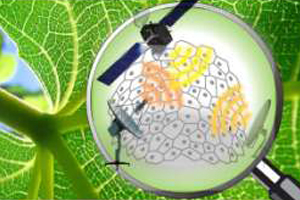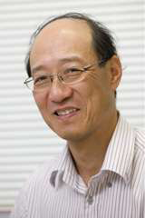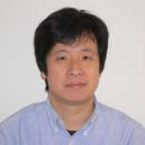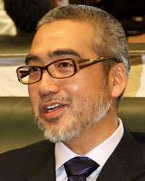
The International Human Frontier Science Program (HFSP) Organization, which is an organization that supports collaborative research in life sciences, announced the 23 winning teams of the 2013 Program Grants. Associate Professor Li Chun Biu at the Research Institute for Electronic Science (RIES, Director Prof. Hiroaki MISAWA), Hokkaido University, won the HFSP Program Grant. The research project is about the coordination behind morphogenesis. Assoc. Prof. Li will disclose how an organism almost always obtains consistent size and shape at the tissue level, while there are various existing stochastic elements at the cellular level, including defects and over-expressions in the process of cell division. Only 23 teams were selected from over 700 original letters of intent. The laboratories of 6 awardees are located in Japan. Five of them are life scientists. Assoc. Prof. Li is the only mathematical scientist from Japan.
Many organisms have a remarkably consistent shape, but at the cellular level cell growth and shape can be highly variable. As a theoretical biophysics, Assoc. Prof. Li will address a key question in developmental biology: how does an organism reach its final size and shape, in the face of stochastic variation at the cellular level? By closely collaborating with experimentalists, Assoc. Prof. Li will develop novel data-driven modeling techniques based on information theory to extract the underlying spatio-temporal patterns of correlations between cells, notably to qualify the most plausible coordinating mechanism that regulates cell stochasticity.
Leading the team is Prof. Arezki Boudaoud, a system biologist from ENS de Lyon in France (which is an institute with which RIES has established the academic agreement to promote new international collaboration) will use micromechanical methods (e.g., AFM) to measure cell wall stiffness and analyze coordinating mechanisms related to mechanical signals. Assist. Prof. Adrienne Roeder, an expert in plant genetics and development at Cornell University in the United States, will perform live imaging to obtain growth data and conduct the screen for mutants with increased variability in organ shapes. Assoc. Prof. Richard S. Smith, a computation scientist and 3D imaging expert at University of Bern in Switzerland will use the cellular force microscope to measure turgor pressure and develop cell-based models accurate for local organ growth, integrating mechanics and signaling.
Previous researches have considered only average cell behaviors, overlooking local heterogeneity and stochastic variation. Therefore, how the entire tissue overcomes and coordinates stochasticity and heterogeneity on the cellular level and how the final size and shape of an organism are determined remains poorly understood. The goal of the team is to resolve this apparent contradiction between the cellular and organismal levels.
This is the fourth Program Grant for RIES (see below), which is an outstanding number for Japan. The number of awardees from RIES is the third highest, exceeded only by RIKEN (14 awardees) and the University of Tokyo (9 awardees) in Japan. In particular, in the case of RIES, all 4 awardees belong to a single institution affiliated with the university. The total number of academic staffs (professors, [specially appointed] associate professors, [specially appointed] assistant professors, and post-doctoral research fellows) in RIES is 66. Compared to the size of RIKEN (14 awardees in 6 institutions, 9 of them belong to the RIKEN Brain Science Institute [the total number of academic staffs is 306]) and that of the University of Tokyo (9 awardees in 1 institution and 8 departments), the percentage of RIES scientists who won this award is worthy of special mention. Among the 38 awardees of the universities and institutions who won the Program Grant more than twice in the past 10 years, there was only 1 awardee from the field of mathematic and mathematical science, except for the 4 awardees from RIES. This simply shows the international recognition of Hokkaido University that puts great value on the collaborations of mathematics and various other fields. This fact also illustrates that RIES and the Research Center for Integrative Mathematics in Hokkaido University are the core facilities contributing toward modern biology, from molecules to cells, tissues, and brain, from the perspective of mathematics and mathematical science.

| Name of the Program | From stochastic cell behavior to reproducible shapes: the coordination behind morphogenesis |
|---|---|
| Team Member | Assoc. Prof. Chun Biu LI (Research Institute for Electronic Science, Hokkaido University, Sapporo, JAPAN), Prof. Arezki BOUDAOUD (Dép. de Reproduction et Développement des Plantes ENS Lyon, FRANCE), Assist. Prof. Adrienne ROEDER (Weill Institute for Cell and Molecular Biology and Dept. of Plant Biology, Cornell University, Ithaca, USA), Assist. Prof. Richard S. SMITH (Institute of Plant Sciences/Mathematical Biology, University of Bern, SWITZERLAND) |
| Period | 2013–2015 |
| Amount of award | $450,000 per year/team (Total Amounts $1,350,000/team) |
| Supplementary Explanation |
|
| Reference | Past records of awards in Research Institute for Electronic Science (RIES) and Research Center for Integrative Mathematics, Hokkaido University |

| Name of the Program | Deliberative decision-making in rats |
|---|---|
| Team Member | Prof. TSUDA Ichiro (Research Institute for Electronic Science, Hokkaido University, Sapporo, JAPAN), Prof. REDISH A. David (Dept. of Neuroscience, University of Minnesota, Minneapolis, USA), Prof. LAUWEREYNS Jan (School of Psychology, Victoria University of Wellington, Wellington, New Zealand), Prof. WOOD Emma (Centre for Cognitive and Neural Systems, University of Edinburgh, Edinburgh, UK) Prof. DUDCHENKO Paul (Dept. of Psychology, University of Stirling, Stirling, UK) |
| Period | 2010-2012 |
| Amount of award | $450,000 per year/team (Total Amounts $1,350,000/team) |

| Name of the Program | Dynamical coordination in a multi-domain, peptide antibiotic mega-synthetase |
|---|---|
| Team Member | Prof. KOMATSUZAKI Tamiki (Research Institute for Electronic Science, Hokkaido University, Sapporo, JAPAN), Prof. MOOTZ Henning (Faculty of Chemistry/ Lab of Chemical Biology and Biochemistry, TU Dortmund University, Dortmund, Germany), Assoc. Prof. YANG Haw (Dept. of Chemistry, Princeton University, Princeton, USA) |
| Period | 2010-2012 |
| Amount of award | $350,000 per year/team (Total Amounts $1,050,000/team) |

| Name of the Program | Optimization in natural systems: ants, bees and slime moulds |
|---|---|
| Team Member | Assoc. Prof. NAKAGAKI Toshiyuki (Research Institute for Electronic Science, Hokkaido University, Sapporo, JAPAN), Prof. SUMPTER David (Mathematics Institute, Uppsala University, Uppsala, SWEDEN), Prof. BEEKMAN Madeleine (Behaviour and Genetics of Social Insects Lab, School of Biological Sciences, University of Sydney, Sydney, AUSTRALIA), Prof. MIDDENDORF Martin (Dept. of Computer Science, University of Leipzig, Leipzig, GERMANY) |
| Period | 2007–2009 |
| Amount of award | $450,000 per year/team (Total Amounts $1,350,000/team) |










